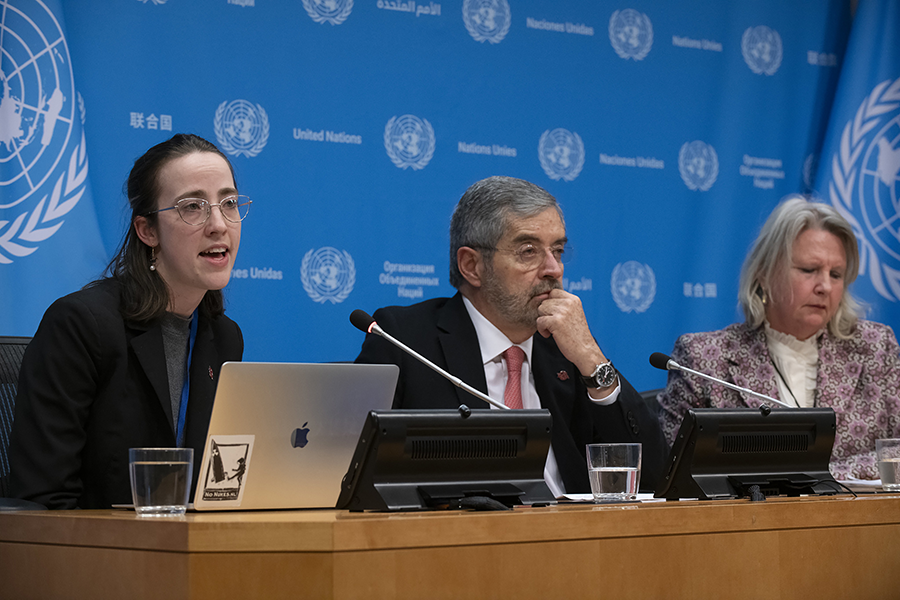“Right after I graduated, I interned with the Arms Control Association. It was terrific.”
TPNW States Challenge Nuclear Deterrence Doctrine
January/February 2024
By Shizuka Kuramitsu
States-parties to the Treaty on the Prohibition of Nuclear Weapons (TPNW) have begun challenging the long-standing deterrence rationale for nuclear weapons in an effort to inject new momentum into their campaign to rid the world of these armaments.
 At their second annual TPNW meeting held Nov. 27 to Dec. 1 in New York, they approved a political outcome document that unveiled the new strategy, declaring that the states-parties “will not stand by as spectators to increasing nuclear risks and the dangerous perpetuation of nuclear deterrence.”
At their second annual TPNW meeting held Nov. 27 to Dec. 1 in New York, they approved a political outcome document that unveiled the new strategy, declaring that the states-parties “will not stand by as spectators to increasing nuclear risks and the dangerous perpetuation of nuclear deterrence.”
At the suggestion of the Austrian delegation, the states-parties decided to establish a “consultative process on security concerns of TPNW states” that aims to reframe the debate over nuclear disarmament as a necessary instrument to ensure human security and national security.
“This shift at the TPNW conference indicated in Austria’s working paper is important. There are deep flaws in the assumptions that underline the current nuclear paradigm, and deterrence, although [it] works most of the time, is inherently flawed and will fail over the long run,” Ward Hayes Wilson, executive director of RealistRevolt, told Arms Control Today.
Amid a deteriorating international security environment due to the Russian war in Ukraine and other factors, nuclear-armed states recently have reaffirmed the need to possess nuclear weapons on the grounds that such armaments deter adversaries. This nuclear deterrence doctrine has been at the core of NATO’s mutual security guarantee and collective defense since the alliance was created in 1949.
At the meeting, Germany, a TPNW observer state, stressed that, “confronted with an openly aggressive Russia, the importance of nuclear deterrence has increased for many states.”
“Germany, as a NATO member, is fully committed to NATO’s nuclear deterrence, the purpose of which is to preserve peace, deter aggression, and prevent nuclear coercion,” the head of the German delegation said.
Similarly, during a meeting of the Group of Seven industrialized countries in Hiroshima in May, world leaders reaffirmed their view that “our security policies are based on the understanding that nuclear weapons, for as long as they exist, should serve defensive purposes, deter aggression and prevent war and coercion.”
But in their political document, the TPNW states-parties countered that “[t]he renewed advocacy, [and] insistence on and attempts to justify nuclear deterrence as a legitimate security doctrine [give] false credence to the value of nuclear weapons for national security and dangerously [increase] the risk of horizontal and vertical nuclear proliferation.”
In addition, nuclear threats “only serve to undermine the disarmament and non-proliferation regime and international peace and security,” the declaration stated.
The states-parties named Austria as coordinator for the new consultative process and called for a report to be submitted at the next TPNW meeting with a set of arguments and recommendations.
The process is expected “to better promote and articulate the legitimate security concerns, [and] threat and risk perceptions enshrined in the treaty that result from the existence of nuclear weapons and the concept of nuclear deterrence,” the parties decided.
Further, states-parties in partnership with scientists and civil society decided “to challenge the security paradigm based on nuclear deterrence by highlighting and promoting new scientific evidence about the humanitarian consequences and risks of nuclear weapons and juxtaposing those with risks and assumptions that are inherent to nuclear deterrence.”
Reflecting this move to delegitimize nuclear weapons, Juan Ramón de la Fuente, the Mexican ambassador who served as the TPNW meeting president, told a press conference on Dec. 1 that “there is an incompatibility between nuclear weapons and international security. That is why we are more convinced now than before [that] the only way to really move towards [a] more secure world for all of us is with the prohibition of nuclear weapons.”
At Mexico’s initiative, the meeting reinforced the new strategy by elevating debate on the humanitarian impact of nuclear weapons use and by including scientists from the newly established TPNW scientific advisory group, a speaker from the International Committee of Red Cross, and representatives of nongovernmental organizations and affected communities, including Australia, Kiribati, and Japan, to share their perspectives and findings.
“This was extremely important because it was the first time that we were addressing at this level [of an official UN conference] the catastrophic humanitarian consequences of nuclear detonation,” de la Fuente said.
Setsuko Thurlow, an atomic bomb survivor from Hiroshima, told the press conference that “[n]ow with the humanitarian initiative as a guide, we were able to look at the [nuclear weapons] issue as a human issue, to put human being[s] right in front and a center of discussion.”
Some 59 states-parties, 35 observer states, and 122 nongovernmental organizations, participated in the weeklong TPNW meeting, which elected Akan Rakhmetullin, Kazakhstan’s UN ambassador, as president of the next meeting, to be held in March 2025.
